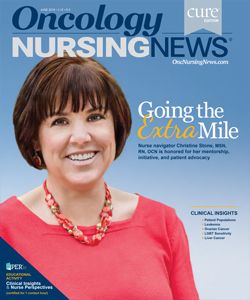Creating New Roles in Nursing
One small group of oncology nurses in a large hospital system developed an innovative nursing position to satisfy both patients and providers.
Ashley Hay, BSN, RN

Ashley Hay, BSN, RN
Nurses are resourceful. Many are frequently challenged by less than ideal conditions, such as lack of supplies and high nurse-to-patient ratios. Being on the front line allows us to see the cracks in the healthcare system and how they affect the patient experience firsthand. Using our assessment skills, we are often able to see workflow issues, areas that need improvement, and potential solutions.
An ideal healthcare experience is patient centered; however, longstanding workflows, procedures, and policies sometimes dictate otherwise. To continue providing quality care, nurses must be willing to think outside the box. Innovation is crucial when trying to adapt models of care in a fast-paced and ever-changing field.
In 2009, I started a new outpatient position as a nurse at Memorial Sloan Kettering Cancer Center (MSK) in New York City. I had worked on several inpatient units at MSK for 3 years prior, so I knew it was a welloiled machine with many processes already in place. This outpatient specialty unit alone treated 80-plus patients a day. Having had previous experience in several other inpatient settings, I felt my nursing knowledge was solid. I was confident that I could easily transition to outpatient care. However, I quickly learned that this unit required a different way of working, and I needed to keep up.
There was minimal time to ask why things were done a certain way. Maintaining speed and accuracy were musts for remaining a reliable part of the team. Rocking the boat was met with some resistance by more seasoned nurses who had practiced a certain way and run the unit well for many years.
As I learned the ropes, I realized we had an opportunity to make a great improvement in the patient experience. When patients returned to the clinic for chemotherapy administration after their lab results came back, they would all ask the same question: “Why aren’t we using my port to draw labs?” It was a question I had pondered myself. The patient was subjected to 2 “sticks” at every appointment—1 venipuncture and 1 port access. But changing the entire process seemed impossible. This was “the way it had always been done.”
CHALLENGING THE STATUS QUO
Creating new roles in nursing can seem overwhelming, especially when lack of staff is already an issue. When I raised the idea of taking a nurse away from bedside care in a busy outpatient setting to focus solely on port access, it was not initially met with a positive reception. Many nurses saw just the increase in patient ratios. However, I knew that if we reallocated current resources, we could improve our efficiency and overall patient satisfaction. I was dedicated to fixing this issue for my patients, who were already dealing with so much. I felt that if we could alleviate just 1 small point of stress, it might make their long day in our clinic a little bit easier. And it did.
GETTING BUY-IN FROM COLLEAGUES
Generating buy-in might feel like waging an uphill battle. Not everyone adjusts well to change. I enlisted the help of my clinical nurse specialist, Beth Boseski, ANP-BC, OCN and we were able to encourage the staff to try the new role themselves. That allowed them to see firsthand how appreciative the patients were for the new service provided—and how it sped along the process of getting chemotherapy up and running for each patient on the unit. Beth also encouraged me and the task force we had created to write an abstract on the implementation of the new process and submit it to the Oncology Nursing Society (ONS). Once other nurses realized that the data they were collecting daily for this innovative project were important on a higher level, they were more than willing to help our cause and became interested in the results.
ASSESS AND REASSESS
The key to fixing any workplace issue is often assessment. Once a problem has been identified, it can be helpful to outline the current workflow and all personnel involved. In my case, the workflow seemed to satisfy everyone involved except the patient. Patients would first be seen by a phlebotomist to obtain their height, weight, vital signs, and laboratory specimens via venipuncture. However, patients who had chosen to receive a Mediport felt as though their central line was being underutilized, and I very much agreed. Consider the patient’s perspective: Imagine that you agreed to have a port installed, then find out later that providers would access it just when it was convenient for their workflow. That was never the intention of the process and certainly not the kind of care image we wanted to project to our valued patients.
Once the issue was identified, it was time to track a few metrics. How many patients had ports? How much time did each port access take, on average? Were we saving infusion chair time with each appointment? It turned out that by allocating 1 nurse to handle initial assessment and port access for about 50 patients per day, the infusion RNs were able to start infusions more quickly. The patient was happier and well prepped for the impending chemotherapy visit.
Follow-up, too, is important when attempting to change any formal process. Assessment does not stop once a project has been implemented, and it is common to find kinks along the way. After conducting 2 patient satisfaction surveys months apart, we were pleased to find that both times, overall satisfaction ratings with the new process were over 95%. The numbers validated that we had identified and fixed a prominent issue among our patients. This innovative project was well received and continues to run successfully many years later.
I cowrote an abstract on the process improvement project and submitted it to the ONS, and it was accepted. As primary author, I was proud to present the project at a poster session of the society’s annual congress.
Tricia McBride, BSN, RN, OCN, coauthor of the abstract, has this advice for other nurses who wish to implement change in their own setting: To create change, one must understand the many steps involved. Have multidisciplinary meetings with stakeholders, collect data, survey patients, and periodically reevaluate. “It’s important to involve as many members of the team as possible to understand how others view the problem,” she says. “Naturally, we look at how the problem directly impacts us or our patients, but when we also appreciate the views of others, we are better prepared to come up with a solution.”
If you notice an area in need of improvement, speak up. Don’t be afraid to innovate, propose a new solution, or create a role when it has the potential to greatly enhance the patient experience.
REFERENCES
1. Dantoni T. MediPort nurse program increases patient satisfaction. Oncology Nurse Advisor website. oncologynurseadvisor.com/ons-annual-congress-2012/mediport-nurse-program-increases-patient-satisfaction/article/239764. Published May 4, 2012. Accessed May 3, 2018.
2. Moore A, McBride T, Thomas L, Boseski B. One less IV stick: developing a MediPort nurse program to increase patient satisfaction. Oncol Nurs Forum. 2012;39(3):E179-E180. Abstract 1331873.

Innovative Program Reduces Nurse Turnover and Fosters Development
Published: September 12th 2024 | Updated: September 12th 2024The US Oncology Network (The Network) has developed one of the most comprehensive programs in the nation to support the professional development and retention of new oncology nurses.



